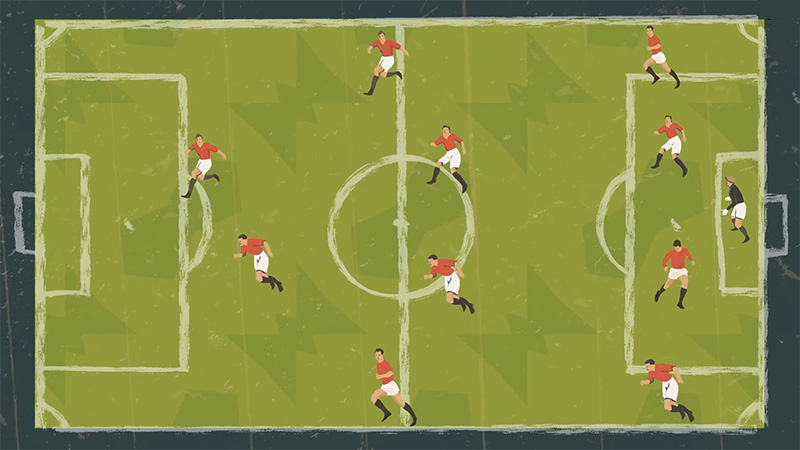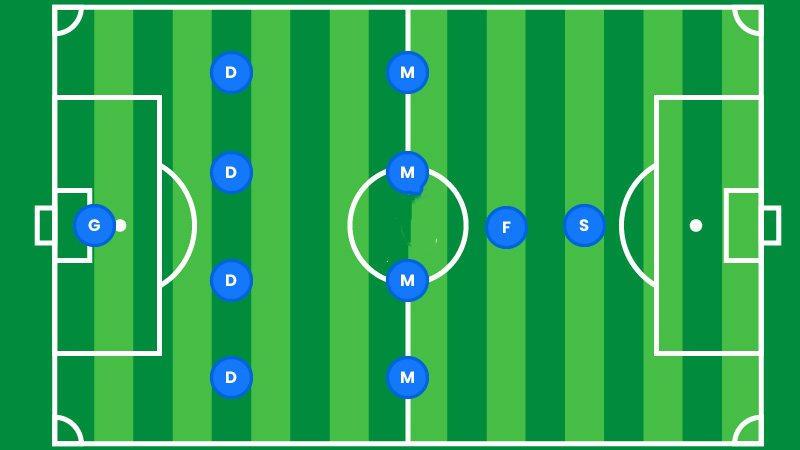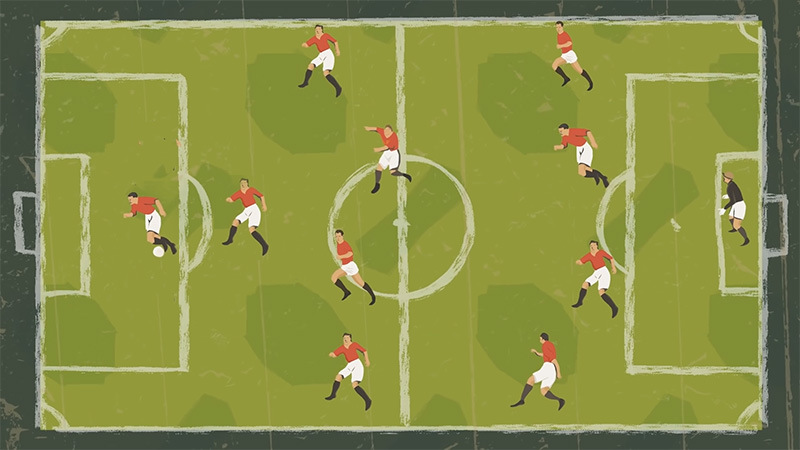The 4-4-1-1 soccer formation is a tactical setup that has gained popularity in modern football due to its ability to strike a balance between defensive solidity and attacking prowess.
Comprising four defenders, four midfielders, one attacking Midfielder, and one striker, this formation offers a well-structured and organized system on the field.
The deployment of a central attacking midfielder right behind the striker provides a creative focal point in the attacking third, while the four-man midfield ensures control and possession in the center of the pitch.
This formation’s versatility enables teams to adapt to various match scenarios, making it a favored choice for many coaches and clubs seeking a tactical approach that emphasizes both defensive resilience and attacking ingenuity.
What Is A 4-4-1-1 4-4-1-1 Soccer Formation?
The 4-4-1-1 soccer formation is a tactical setup that consists of four defenders, four midfielders, one attacking Midfielder, and one striker.
This formation is commonly used by teams seeking a balance between defensive solidity and attacking support. Let’s break down each component of this formation:
Defenders (4):
The four defenders typically form a backline consisting of two central defenders and two full-backs.
Their primary role is to provide defensive stability, marking opposing forwards, intercepting passes, and clearing the ball from dangerous areas.
The central defenders act as a shield in front of the goal, while the full-backs also contribute to the team’s attacking play by providing width and overlapping the midfielders.
Midfielders (4):
The four midfielders are usually deployed in two pairs, with two central midfielders and two wide midfielders.
The central midfielders control the game’s tempo, dictate play, and provide support to both defense and attack. They are responsible for distributing accurate passes, breaking up the opponent’s plays, and initiating attacks.
The wide midfielders, often known as wingers, play a crucial role in stretching the opposition’s defense, delivering crosses into the box, and tracking back defensively when needed.
Attacking Midfielder (1):
Positioned just behind the striker, the attacking Midfielder is the creative hub of the team.
This player’s main task is to link the midfield with the lone striker and orchestrate attacking moves.
They are often skilled dribblers and playmakers responsible for unlocking the defense with through balls, incisive passes, and shots from a distance.
Striker (1):
The lone striker is the main goal-scoring threat in the formation. This player’s role is to stay high up the pitch, stretch the opponent’s defense, and capitalize on scoring opportunities.
The striker must have a good sense of positioning, be adept at holding up the ball, and possess a clinical finishing ability to convert chances into goals.
Overall, the 4-4-1-1 formation combines defensive solidity, midfield control, and attacking options, making it an attractive choice for teams looking to maintain a strong defensive structure while still having the capacity to threaten the opposition’s goal.
It requires well-coordinated movement and effective communication between players to succeed, as each position plays a vital role in the team’s overall performance.
Is The 4-4-1-1 Formation Popular In Soccer?

The 4-4-1-1 formation had been used by various soccer teams worldwide, but it wasn’t one of the most popular formations.
Its popularity fluctuates over time as teams and managers adapt their tactics based on player strengths, opponent analysis, and game situations.
Let’s explore the reasons for its popularity and its advantages:
Tactical Flexibility:
The 4-4-1-1 formation offers a good balance between defense and attack, making it an adaptable choice for different scenarios.
Teams can shift between a solid defensive shape with two compact banks of four and a more offensive approach by pushing the attacking Midfielder closer to the striker.
Midfield Control:
With four midfielders, this formation provides numerical superiority in the middle of the field, enabling teams to control possession and dictate the game’s tempo.
The central midfielders can dominate the play and provide passing options in various directions.
Defensive Stability:
The four defenders provide a strong defensive foundation, reducing the risk of being exposed to counterattacks.
The formation can be particularly effective against teams with strong attacking threats, as it offers support to the defensive line.
Attacking Support:
Despite having just one striker, the presence of an attacking midfielder can help create additional scoring opportunities. This player can act as a link between the midfield and the lone striker, providing through balls and taking shots from a distance.
However, the 4-4-1-1 formation also has some challenges that may contribute to its less widespread usage:
Lack of Width:
The formation relies heavily on the wide midfielders to provide width and stretch the opposition’s defense.
If the wingers are not adept at this role, the team’s attacking options may become limited.
Overcrowded Midfield:
While having four midfielders can offer control, it might lead to congestion in the central areas, making it difficult to break down defensively disciplined opponents.
Striker Isolation:
The lone striker can sometimes become isolated from the rest of the team if the attacking Midfielder doesn’t effectively support them or if the opposition’s defense is compact and organized.
The 4-4-1-1 formation has been used in soccer, but its popularity may vary depending on tactical trends and the preferences of individual teams and managers.
While it offers a balanced approach to the game, it also presents some challenges that teams must address to make it successful.
What Are The Strengths Of The 4-4-1-1 Soccer Formation?

Source: rookieroad
The 4-4-1-1 soccer formation possesses several strengths that make it an attractive tactical choice for certain teams and situations.
Here are some of its key strengths:
Defensive Solidity:
The 4-4-1-1 formation provides a strong defensive structure with four defenders and a compact midfield.
The two banks of four players make it challenging for opponents to penetrate through the center of the field.
This solidity can help teams maintain defensive discipline and minimize the risk of conceding goals, especially against strong attacking opponents.
Midfield Control:
With four midfielders, this formation excels at controlling the middle of the pitch. The central midfielders work as a unit to win possession, distribute the ball efficiently, and disrupt the opponent’s passing lanes.
The numerical advantage in midfield allows teams to dominate possession and dictate the tempo of the game.
Attacking Link:
The attacking Midfielder in the 4-4-1-1 formation acts as a crucial link between the midfield and the striker.
This player can roam in the space between the opponent’s defense and midfield, creating chances with through balls and accurate passes.
The presence of the attacking Midfielder adds an element of creativity and unpredictability to the team’s attacking play.
Counterattacking Potential:
The 4-4-1-1 formation is well-suited for quick counterattacks. With four midfielders positioned centrally, the team can quickly win the ball back in transition and launch fast breaks.
The attacking Midfielder and the lone striker can exploit the spaces left by retreating opponents, creating dangerous opportunities on the counter.
Defensive Pressing:
The 4-4-1-1 formation enables effective pressing when out of possession. The compactness of the midfield and defense allows the team to apply pressure collectively, making it difficult for the opposition to build up play from the back.
This pressing style can lead to regaining possession high up the pitch and creating chances from turnovers.
Flexibility:
The 4-4-1-1 formation offers tactical flexibility. Depending on the game’s flow and the opposition’s strengths and weaknesses, teams can adjust their shape to shift between a more defensive or offensive approach.
The attacking midfielder can drop deeper to support the midfield defensively or push higher to form a more attacking 4-2-3-1 structure.
Overall, the 4-4-1-1 formation’s strengths lie in its defensive solidity, midfield control, attacking link play, counterattacking potential, pressing capabilities, and tactical adaptability.
When executed well with players who suit the roles, this formation can be a potent tactical setup for teams aiming to strike a balance between defensive resilience and attacking threats.
What Are The Weaknesses Of The 4-4-1-1 Soccer Formation?
While the 4-4-1-1 soccer formation boasts several strengths, it is not without its weaknesses. As with any tactical setup, teams need to be aware of the potential drawbacks and address them accordingly.
Here are some of the weaknesses of the 4-4-1-1 formation:
Lack of Width:
The formation’s reliance on two wide midfielders for providing width can be a double-edged sword.
If these players fail to stretch the opposition’s defense adequately, the attacking play may become predictable and easier to defend against.
The lack of width can also limit crossing opportunities into the box, reducing the chances for the lone striker to capitalize on aerial balls.
Vulnerability to Overload in Midfield:
While having four midfielders can provide control, it can also lead to congestion in the central areas.
Skilled opponents may overload the midfield with their own players, neutralizing the formation’s numerical advantage and stifling the team’s ability to move the ball effectively through the middle.
Isolation of the Striker:
The lone striker in the 4-4-1-1 formation can become isolated from the rest of the team if the attacking Midfielder doesn’t effectively support them.
Without adequate supply and support, the striker may find it difficult to hold up play and link with teammates, reducing the team’s attacking threat.
Lack of Defensive Cover on the Wings:
With only two central midfielders and four defenders, the 4-4-1-1 formation may lack sufficient defensive cover on the wings.
Skilled opposition wingers or full-backs can exploit this space, potentially leading to dangerous crosses and attacking opportunities down the flanks.
Creative Overload on the Attacking Midfielder:
The success of the formation heavily relies on the performance of the attacking Midfielder.
If this player faces an excellent defensive marking or has an off-day, the team’s creative output may suffer significantly. Relying too much on a single player can make the formation predictable and easier for the opposition to neutralize.
Transition Vulnerabilities:
While the formation can be effective in counterattacking situations, its compactness in midfield and defense can also leave it susceptible to fast counterattacks from opponents.
Quick turnovers can expose the space left behind by pushing players forward, leading to potential defensive vulnerabilities.
The 4-4-1-1 formation’s weaknesses center around the lack of width, potential midfield congestion, isolation of the striker, defensive vulnerabilities on the wings, over-reliance on the attacking Midfielder, and susceptibility to counterattacks.
To mitigate these weaknesses, teams must focus on tactical discipline, individual player strengths, and strategic adjustments during matches to ensure the formation remains effective in different scenarios.
FAQ
What is the 4-4-1-1 soccer formation?
Answer: The 4-4-1-1 soccer formation is a tactical setup that consists of four defenders, four midfielders, one attacking Midfielder, and one striker. The formation is characterized by two banks of four players in the midfield and a central attacking midfielder positioned just behind the lone striker.
What are the main strengths of the 4-4-1-1 formation?
Answer: The strengths of the 4-4-1-1 formation include its defensive solidity with four defenders and a compact midfield, allowing teams to maintain a strong defensive shape. The four midfielders provide numerical superiority in the middle of the pitch, facilitating control of possession and dictating the game’s tempo.
How can teams overcome the lack of width in the 4-4-1-1 formation?
Answer: Overcoming the lack of width in the 4-4-1-1 formation can be achieved by utilizing full-backs that provide width by overlapping and delivering crosses from the flanks.
Is the 4-4-1-1 formation vulnerable to counterattacks?
Answer: While the 4-4-1-1 formation can be effective in counterattacks, its compactness in midfield and defense can leave it vulnerable to fast counterattacks from opponents.
How can teams adapt the 4-4-1-1 formation for different match scenarios?
Answer: Teams can adapt the 4-4-1-1 formation by making tactical adjustments based on their opponent’s strengths and weaknesses. For instance, if facing a strong attacking team, the midfielders can focus on defensive duties and support the backline.
Conclusion
The 4-4-1-1 soccer formation remains an intriguing tactical option that continues to influence the modern game. Its well-balanced structure, with four defenders, four midfielders, and the attacking Midfielder supporting the lone striker, allows for effective control of the midfield and creative attacking opportunities.
Despite its strengths, the formation also faces challenges, such as a potential lack of width and isolation of the striker. However, with skilled players and proper tactical adjustments, these weaknesses can be mitigated.
The formation’s flexibility makes it adaptable to different playing styles and player strengths, adding an element of unpredictability to a team’s approach.
As soccer evolves, the 4-4-1-1 formation will likely continue to play a significant role in shaping the game’s tactical landscape.







